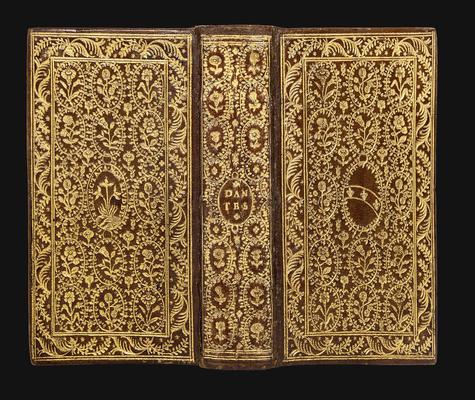Dante Alighieri
Dante con nuove, et utili ispositioni...
Lyon, Guillaume Rouillé, 1571.16° (120x71 mm). Collation: A-Z8, Aa-Rr8. 627, [13] pages. Italic and roman type. Woodcut printer's device on the title-page. Dante's woodcut portrait on fol. A3v; three full-page woodcuts on fols. A5v, P1r and Dd7v, illustrating the beginning of each cantica, already used in the Lyon edition of 1551; the title of each cantica within an architectural woodcut frame. Woodcut decorated initials. Parisian late sixteenth-century olive green morocco, with elaborate gilt tooling. Different flowers interspersed with smaller flower tools, enclosed within borders of leafy sprays, front cover with gilt armorial of Pietro Duodo, rear cover with plant device enclosed by his motto 'expectata elvdet'. Smooth spine decorated with variants of the floral tools, central title cartouche lettered ‘dantes'. Gilt edges. Modern red half leather box. An excellent copy, ruled in red. Light spotting on thetitle-page, a few leaves slightly browned.
Provenance: the Venetian ambassador Pietro Duodo (1554-1611); Edouard Rahir (1862-1924); Livio Ambrogio collection.
An outstanding copy finely bound for the Venetian diplomat Pietro Duodo of the reprint of the 1551 Rouillé edition. From 1594 to 1597, Duodo served as ambassador to King Henryivin Paris, and collected a small but select ‘travelling' library composed mostly of volumes in 12° and 16° format. He commissioned a single Parisian workshop, probably run at that time by the pre-eminent Royal binder Clovis Ève – famous for using the tool a la deuxie me palmette – to produce richly decorated bindings for his books. The volumes on different subjects were classified, according to the fashion of the time, by the colour of the morocco used for the binding: red for theology, philosophy, history and law; citron for medicine and botany; olive green for literature, as with the present copy. Literary works were predominant in his library, with seventy-two volumes listed by Raphaël Esmerianin his census of Duodo's books.
Duodo was recalled to Venice in 1597 and his library remained in Paris, untouched for two centuries. Rediscovered during the French Revolution it did not remain intact and was widely dispersed. The volumes were erroneously ascribed to the collection of Marguerite de Valois (1554-1611), possibly as a consequence of the exquisite daisies stamped on the boards. Only in 1920 did the bibliographer Ludovic Bouland identify Duodo as their true owner, and his books immediately began to be sought after by collectors for their rarity (only 133 volumes from this library have been recorded up to now), their distinguished provenance, and the gilded floral pattern – à ovales floraux – bindings made specially for him.


